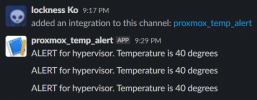Hey just a question does anyone know how to modify the script for a dual socket cpus, as follows for the hack and may be throuw in the gpu in loc1
{
itemId: 'thermal',
colspan: 2,
printBar: false,
title: gettext('CPU temperature'),
textField: 'thermalstate',
renderer:function(value){
const c0 = value.match(/Core 0.*?\+([\d\.]+)?/)[1];
const c1 = value.match(/Core 1.*?\+([\d\.]+)?/)[1];
const c2 = value.match(/Core 2.*?\+([\d\.]+)?/)[1];
const c3 = value.match(/Core 3.*?\+([\d\.]+)?/)[1];
const c4 = value.match(/Core 4.*?\+([\d\.]+)?/)[1];
const c8 = value.match(/Core 8.*?\+([\d\.]+)?/)[1];
const c9 = value.match(/Core 9.*?\+([\d\.]+)?/)[1];
const c10 = value.match(/Core 10.*?\+([\d\.]+)?/)[1];
const c11 = value.match(/Core 11.*?\+([\d\.]+)?/)[1];
const c12 = value.match(/Core 12.*?\+([\d\.]+)?/)[1];
return `Core: ${c0} | ${c1} | ${c2} | ${c3} | ${c4} | ${c8} | ${c9} | ${c10} | ${c11} | ${c12}`
}
}
This has two package ids reading from sensors command
coretemp-isa-0001
Adapter: ISA adapter
Package id 1: +42.0°C (high = +85.0°C, crit = +95.0°C)
Core 0: +37.0°C (high = +85.0°C, crit = +95.0°C)
Core 1: +39.0°C (high = +85.0°C, crit = +95.0°C)
Core 2: +42.0°C (high = +85.0°C, crit = +95.0°C)
Core 3: +34.0°C (high = +85.0°C, crit = +95.0°C)
Core 4: +34.0°C (high = +85.0°C, crit = +95.0°C)
Core 8: +37.0°C (high = +85.0°C, crit = +95.0°C)
Core 9: +38.0°C (high = +85.0°C, crit = +95.0°C)
Core 10: +35.0°C (high = +85.0°C, crit = +95.0°C)
Core 11: +36.0°C (high = +85.0°C, crit = +95.0°C)
Core 12: +36.0°C (high = +85.0°C, crit = +95.0°C)
nvme-pci-4400
Adapter: PCI adapter
Composite: +30.9°C (low = -273.1°C, high = +80.8°C)
(crit = +81.8°C)
Sensor 1: +30.9°C (low = -273.1°C, high = +65261.8°C)
Sensor 2: +33.9°C (low = -273.1°C, high = +65261.8°C)
coretemp-isa-0000
Adapter: ISA adapter
Package id 0: +42.0°C (high = +85.0°C, crit = +95.0°C)
Core 0: +39.0°C (high = +85.0°C, crit = +95.0°C)
Core 1: +42.0°C (high = +85.0°C, crit = +95.0°C)
Core 2: +35.0°C (high = +85.0°C, crit = +95.0°C)
Core 3: +35.0°C (high = +85.0°C, crit = +95.0°C)
Core 4: +39.0°C (high = +85.0°C, crit = +95.0°C)
Core 8: +38.0°C (high = +85.0°C, crit = +95.0°C)
Core 9: +41.0°C (high = +85.0°C, crit = +95.0°C)
Core 10: +42.0°C (high = +85.0°C, crit = +95.0°C)
Core 11: +39.0°C (high = +85.0°C, crit = +95.0°C)
Core 12: +41.0°C (high = +85.0°C, crit = +95.0°C)
i350bb-pci-0103
Adapter: PCI adapter
loc1: +66.0°C (high = +120.0°C, crit = +110.0°C)


